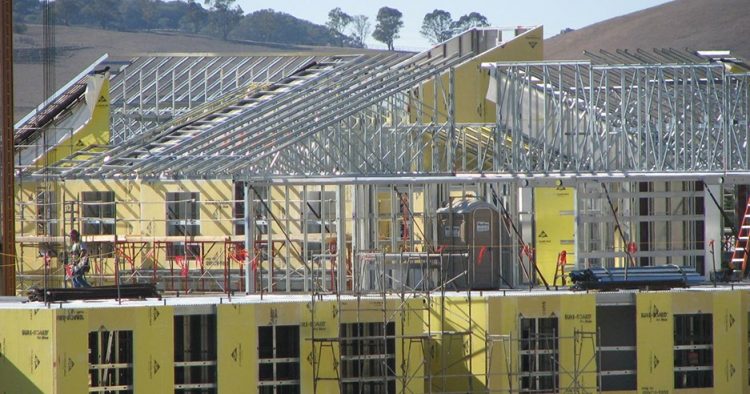AISI Publishes Two New Cold-Formed Steel Research Reports

Photo Credit: Don Allen
WASHINGTON, D.C. – The American Iron and Steel Institute (AISI) has published two new cold-formed steel research reports: “RP20-4: Cold-Formed Steel Bracing Design Using Combinations of Discrete and Sheathing Bracing,” and “RP20-5: Structural Design Example – Four Span Metal Building Z-Purlin Line Supporting a Standing Seam Roof.” Both are available for free download at https://www.buildusingsteel.org and https://www.cfsei.org.
“RP20-4: Cold-Formed Steel Bracing Design Using Combinations of Discrete and Sheathing Bracing” summarizes efforts related to establishing the behavior and design of cold-formed steel wall assemblies potentially braced by discrete steel bracing and wall sheathing. A focused series of experiments on wall stud assemblies in compression with different combinations of discrete bracing and sheathing bracing were completed. The testing indicated that sheathing bracing dominates the braced stud response and that brace forces in discrete braces do not accumulate when sheathing is present. A series of spreadsheets were developed to provide engineers with a clear and efficient means to predict the strength of studs with both discrete bracing and sheathing bracing. The research was conducted by Benjamin Schafer, Ph.D. under the purview of the Cold-Formed Steel Research Consortium.
“RP20-5: Structural Design Example – Four Span Metal Building Z-Purlin Line Supporting a Standing Seam Roof” provides an example step-by-step calculation of a new approach offered in Section I6.1 of AISI S100-16, North American Specification for the Design of Cold-Formed Steel Structural Members, 2016 Edition. Section I6.1 allows for the design of metal building roof purlin lines supporting a standing seam roof by analysis and calculation. The example purlin line structural analysis offered in RP20-5 considers load eccentricity, roof slope, and bracing from the roof clips and roof diaphragm. The example is automated with recently developed open-source software. The research was conducted by Cristopher Moen, Ph.D., P.E. under the purview of RunToSolve, LLC.
“This research enables us to advance cold-formed steel design and guides us on next steps to take in standards development and technology transfer,” said Jay Larson, P.E., F.ASCE, managing director of AISI’s Construction Technical Program. “We appreciate the work of all the researchers involved and the review by members of the AISI Committee on Specifications and the AISI Committee on Framing Standards.”
AISI serves as the voice of the North American steel industry in the public policy arena and advances the case for steel in the marketplace as the preferred material of choice. AISI also plays a lead role in the development and application of new steels and steelmaking technology. AISI’s membership is comprised of integrated and electric furnace steelmakers, and associate members who are suppliers to or customers of the steel industry. For more news about steel and its applications, view AISI’s website at www.steel.org or www.buildusingsteel.org. Follow AISI on Facebook or Twitter (@AISISteel), (@BuildUsingSteel).


